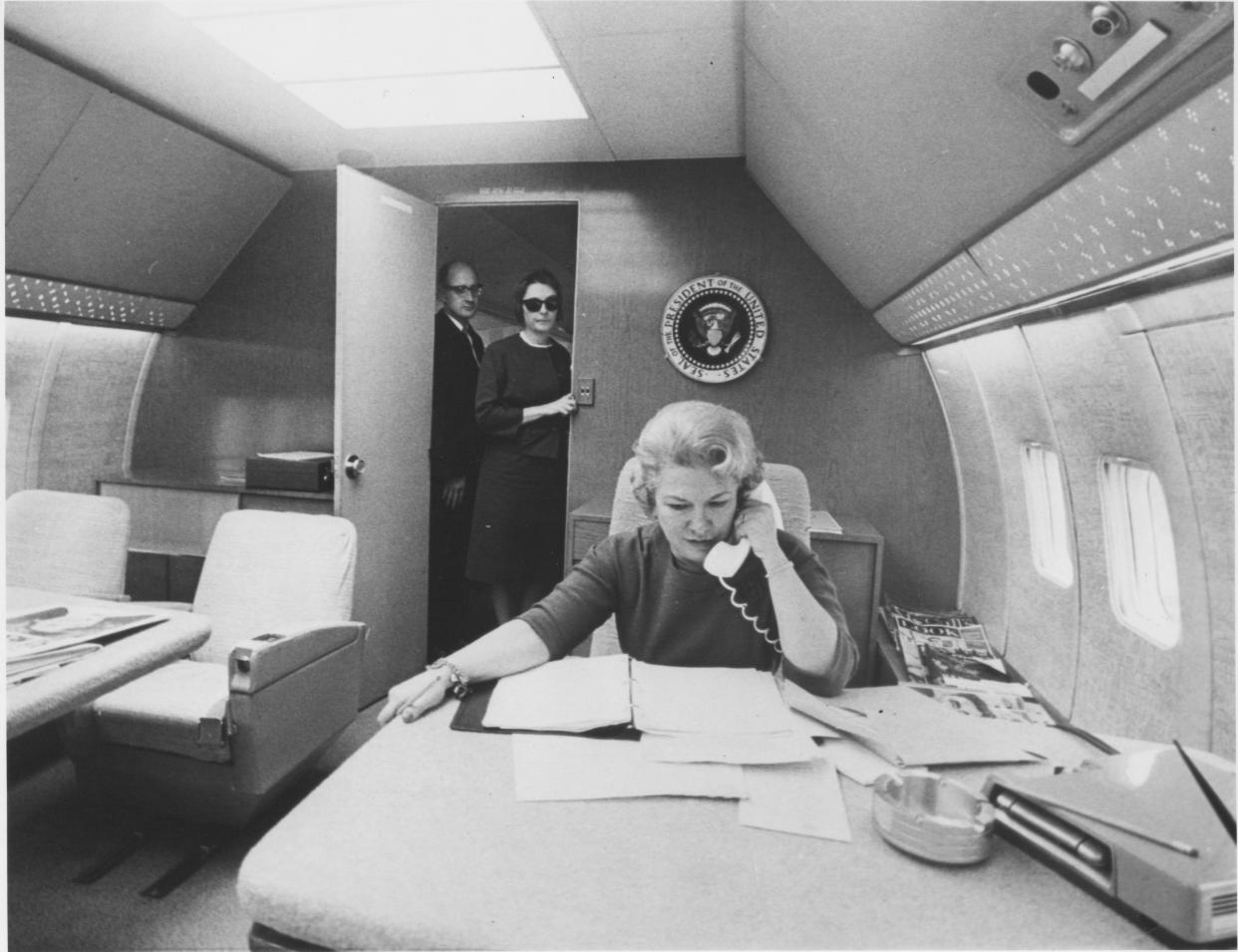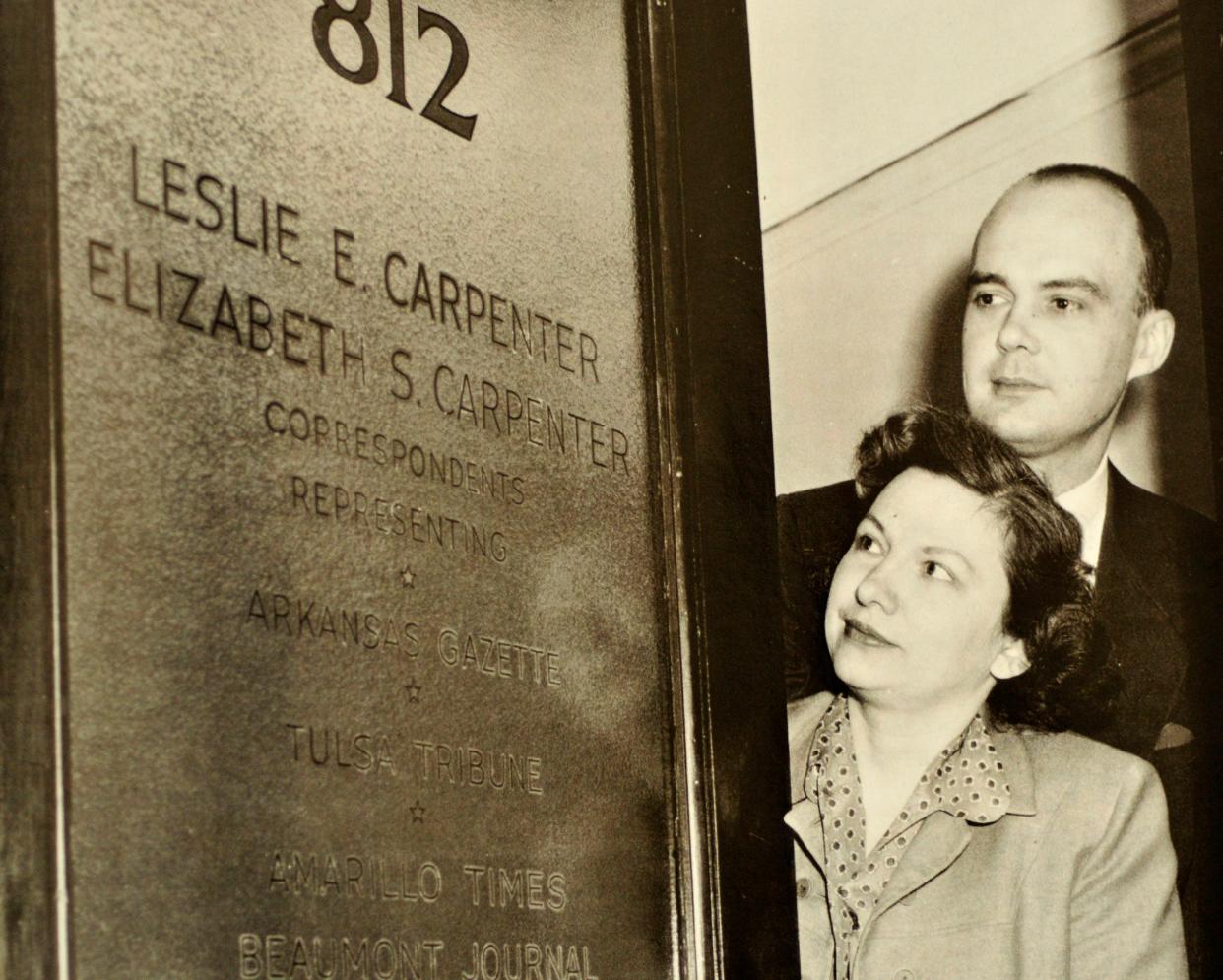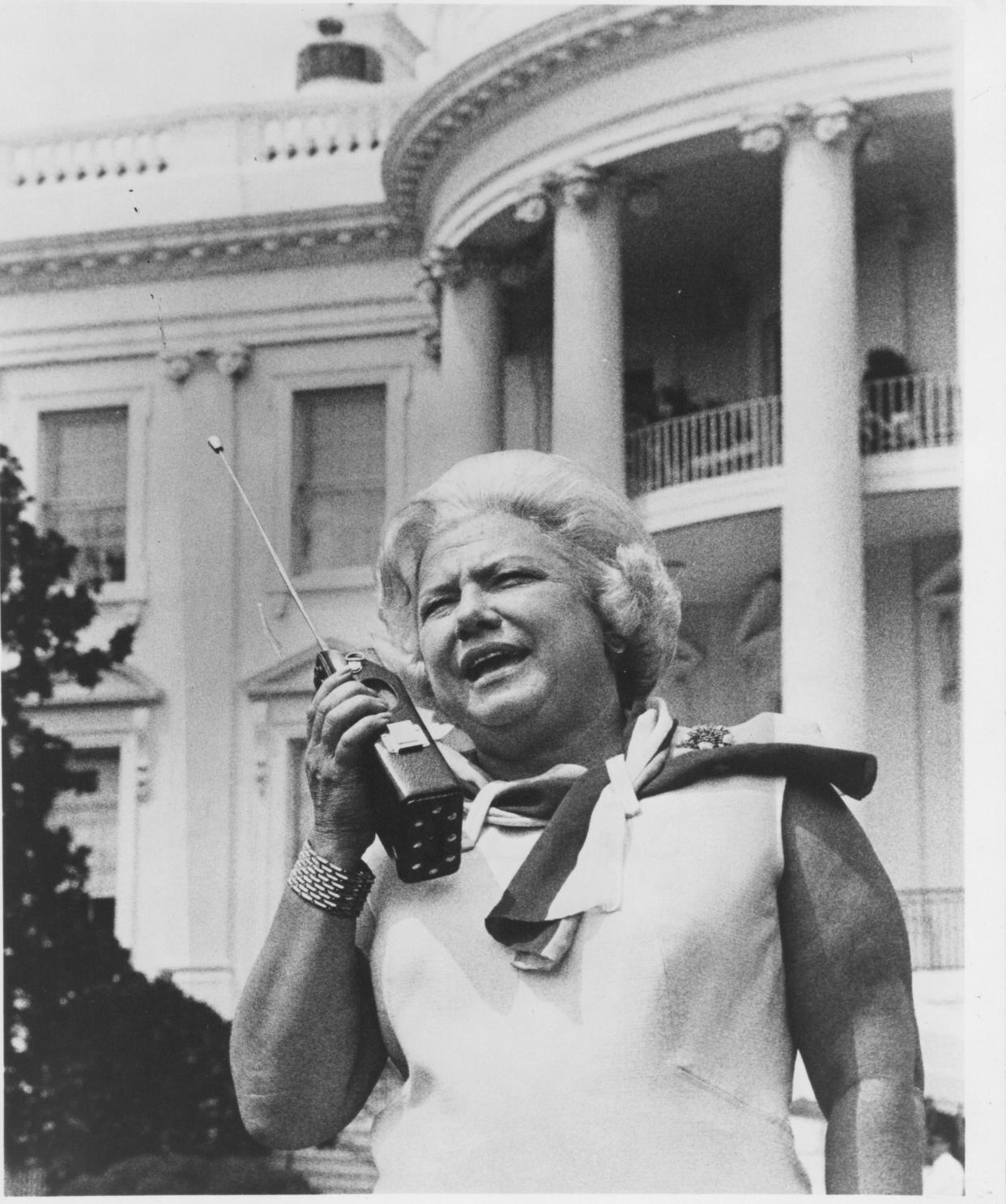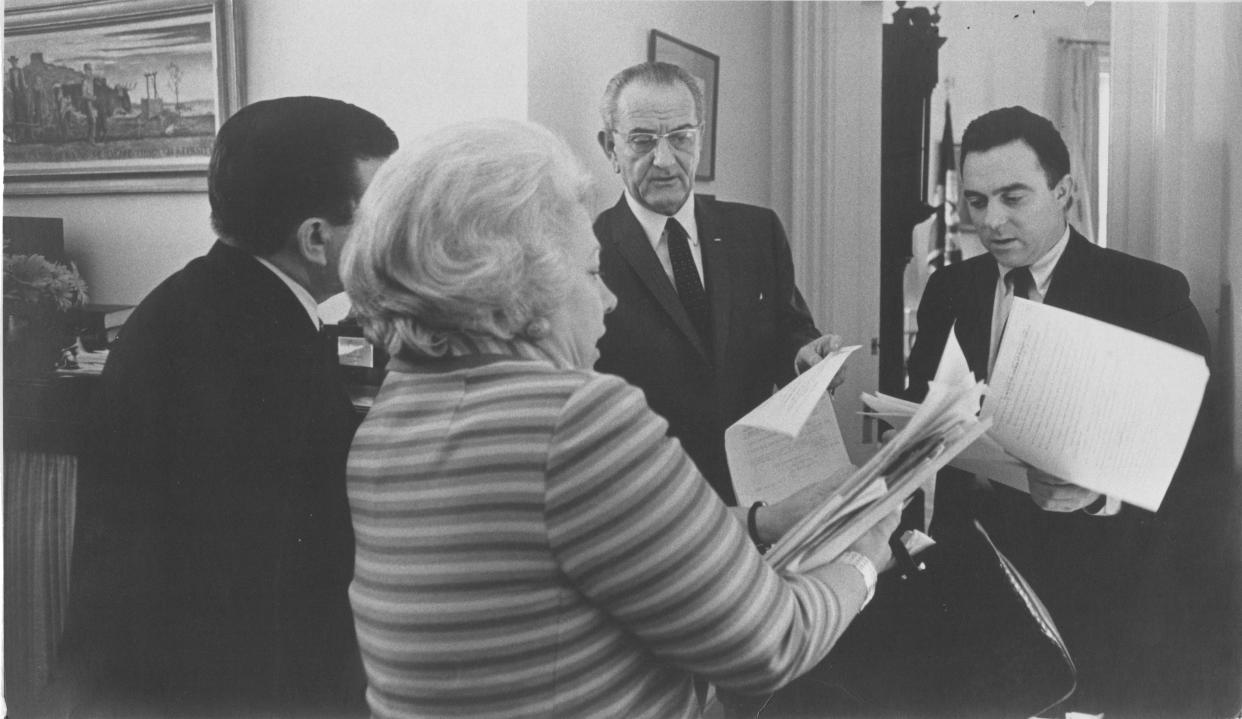'Shaking It Up': View Texas icon Liz Carpenter up close and personal in new documentary

It is one thing to read about Texas icon Liz Carpenter.
It is another thing altogether to watch her in glorious action, bursting onto the national scene as pioneer woman journalist during the 1940s; working as a key aide to Lady Bird Johnson, and before that, Lyndon Baines Johnson in the 1960s; leading the fight across the country for women's rights in the 1970s and beyond. After all that, settling down, not quietly, but joyously, back in Austin, throwing parties, singing songs, howling at the moon, and, as always, getting things done.
That's a part of what we see and hear thanks the new 77-minute documentary, "Shaking It Up: The Life & Times of Liz Carpenter," co-produced and co-directed by her daughter, Christy Carpenter, along with veteran filmmaker Abby Ginzberg.
The movie, which briskly introduces a cascade of archival images as well as an array of short, astute interviews, premiered at South by Southwest during three packed showings. It will be exhibited again on May 21 at the LBJ President Library. Later, the film will be shown at the Bob Bullock Texas State History Museum on Sept. 28. Next year, during Women's History Month, it will appear on public television; you will be able to stream it for free on PBS.org.
More: Get an exclusive look Inside Lyndon B. Johnson's hidden downtown Austin offices
It was good to hear Carpenter's singular voice again. How well I recall those phone calls to the newsroom during the 1990s and early 2000s. The brassy blast from the other end of the line dispensed with any preliminaries: "Now Michael, listen, this is what I need you to do."
Liz Carpenter (1920-2010) had one of those unstoppable personalities — part LBJ, part Lady Bird. She mesmerized almost everyone around her, especially journalists, who knew that whatever Carpenter had in mind would likely lead to a hot story.
You witness that in the movie: Time and again, hordes of reporters and visual journalists swarmed together whenever Carpenter staged an environmental event for Lady Bird, or the times she put together rallies for the Equal Rights Amendment, meant to put women on the same constitutional footing as men. The U.S. Congress passed it overwhelmingly in 1972, but the ERA was stopped just short of full ratification by the states due to a coalition of emerging culture warriors.
To celebrate the film, which will play additional festivals around the country during the coming months, take a look at the following 10 things that might surprise you from this movie about the unparalleled Liz Carpenter.

A long line of strong Central Texas women
It is good to be reminded that Carpenter was a 5th-generation Texan whose early years were spent in the Central Texas town of Salado. I should not have been surprised that she descended from a line of unbowed women, several of whom attended since-gone Salado College, founded by her great-grandfather in 1859, and were suffragists. These days, several small monuments to Carpenter can be found in Salado.
Noted journalist learns her trade in Austin
Carpenter's family moved to Austin when she was seven. She edited the school newspaper at Austin High School, back when it was located on Rio Grande Street. That's where she met her future husband, Les Carpenter, with whom she later founded the Carpenter News Bureau, located in the National Press Building in Washington, D.C. They studied journalism at the University of Texas, then Liz contributed to the Austin American-Statesman, a gig that included frequent interviews with LBJ and Lady Bird.
More: Former TV news anchor and LBJ-family insider Neal Spelce spins intriguing yarns in new memoir
Breaking into the national press corps
Liz Carpenter was hardly welcomed with open arms by the male press corps when she arrived in D.C. as an outspoken Texas reporter. Men ruled the roost. Although most women reporters were relegated to the society pages, Carpenter was a political reporter from the start. She was helped along by first lady Eleanor Roosevelt, who held press conferences exclusively for women reporters. Another unlikely figure also pitched in: Carpenter, as president of the Women's National Press Club, convinced visiting Soviet Premier Nikita Khrushchev to insist on the inclusion of women reporters at his speech to the male-only National Press Club during his showboating trip to the U.S. Brick by brick during Carpenter's two decades as a Washington reporter, the walls fell.
In 1960, LBJ picks Carpenter to help his campaign
LBJ could spot talent a mile away. Liz Carpenter, whose political gifts and speechmaking skills were undeniable, was recruited during his 1960 run for the president. After the election, she joined his vice-presidential staff and accompanied him on the fateful trip to Texas when President John F. Kennedy was assassinated. On the plane back to Washington, Carpenter wrote the short, eloquent speech that the new president gave upon his return.
Johnson chose Carpenter for her self-evident skills. He could be genuinely charming and persuasive to his staff, when he was not outrageously demanding and what today would be considered abusive (a recent book to read on the subject is Tracy Daughtery's "Leaving the Gay Place: Billy Lee Brammer and the Great Society").
More: Take a grand tour of Lyndon B. Johnson's historic offices in Central Texas
Putting together a staff for the first lady
Lady Bird Johnson was the first presidential wife to assemble a professional staff. Although her title was press secretary and chief of staff, Carpenter was much more. She organized events, ironed out every detail, and brought along her press pals anytime the first lady announced a political or policy objective. As described in Julia Sweig's bestseller, "Lady Bird Johnson: Hiding in Plain Sight," Carpenter helped coordinate the efforts of the East and West Wings. Sweig appears in the documentary, along with presidential daughters Luci Baines Johnson and Lynda Bird Johnson Robb, environmental historian Douglas Brinkley, Johnson aide Bill Moyers, journalist Dan Rather (who called Carpenter the "insider's insider" in the Johnson White House) and many others.

Butting heads with the leader of the Free World
Carpenter's closeness to the Johnson family did not exempt her from LBJ's wrath. Yet, as the audio records show, Carpenter, not unlike Lady Bird, stood up to the president time and again. Interestingly, both women used the tactic of talking right through his objections, never raising their voices, as if the outcome would eventually go their way.
An unprecedented campaign for the environment
Quite a few historians have amended the record to show that Lady Bird was no mere "beautifier," instead she was a crucial link between the conservationists of the past and the environmental activists who followed in their footsteps. Her barnburner tours of the U.S. with Secretary of the Interior Stewart Udall sparked the imaginations of Americans regarding their national parks and other natural legacies. Carpenter not only made sure the trains ran on time during these tours, she convinced many otherwise sedentary reporters to take mountain hikes and climb into whitewater rafts to follow them.
More: Austin's LBJ Library will reopen next month -- but this time it's all about Lady Bird
Headlong into women's rights
Not long after the Johnsons returned to the relative quiet of the LBJ Ranch west of Austin in 1969, Carpenter turned her energies to an enormous political project she already supported. The intellectual leaders of the women's movement had laid the groundwork for cultural changes, but it took a political insider and galvanizing speaker like Carpenter to put together the panels, speeches, conferences and tours, meanwhile guaranteeing media coverage for the National Women's Political Caucus and the Equal Rights Amendment campaign. She knew the power of having three first ladies — Lady Bird Johnson, Betty Ford and Rosalynn Carter — on the stage at the same time, along with rising stars such as Rep. Shirley Chisholm, the first Black woman to run for president, and Rep. Eddie Bernice Johnson, whom Carpenter influenced and encouraged, to support the fight for the ERA.
Ann Richards, others follow in Carpenter's footsteps
"Shaking It Up" makes it clear that Carpenter blazed a trail for other Texas women political figures, including Barbara Jordan, Ann Richards, Kay Bailey Hutchison and Sissy Farenthold. If you include some others, such as Molly Ivins and Sarah Weddington, who did not hold office, you behold a generation of women who changed the tune of good ol' boy politics in the state.
More: Remembering Liz Carpenter: Once again, a few words for the grieving
Singing, howling and soaking in Austin
Austinites got to know Carpenter better once she returned to the city and a modest house with a gorgeous view of downtown in the western hills. Carpenter wrote books and threw parties. She dressed up in costumes and adopted young talents. She founded the Getting Better All the Time singing group. People crowded into her hot tub and followed her outside to howl at the moon. There's no denying that she let her hair down.
This movie captures all of that. She was an original in every way.

Michael Barnes writes about the people, places, culture and history of Austin and Texas. He can be reached at mbarnes@gannett.com. Sign up for the free weekly digital newsletter, Think, Texas, at statesman.com/newsletters, or at the newsletter page of your local USA Today Network paper.
This article originally appeared on Austin American-Statesman: New documentary film seizes on Texas political icon Liz Carpenter
